Portal:Latin America/Featured picture list
For featured pictures of 2006, see Portal:Latin America/Featured picture/2006
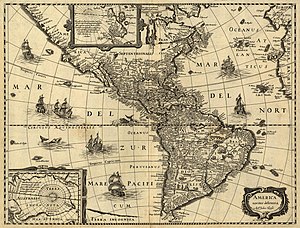 Map by Jodoco Hondio; engraved by H. Picard
Latin American history extends back many centuries, possibly as long as 30,000 years. Precise dating is difficult because there are few text sources. However, highly-developed civilizations flourished at various times and places, such as the Andean Inca and the Central American Maya. Christopher Columbus "discovered" the Americas in 1492. Subsequently, the major sea powers in Europe sent expeditions to the New World to build market lines and colonies. First, concentrating on the central and southern parts of the Americas, the Spanish and Portuguese built large colonial empires in California, Mexico, and Brazil. In the early 19th century most of the countries in the region attained their independence, although a few small colonies remain.
 Photo credit: Brad Mering
Nevado Alpamayo is one of the most conspicuous peaks in the Cordillera Blanca mountain range (which is made up of about 50 peaks), part of the Peruvian Andes. It has two sharp summits, North and South, separated by a narrow corniced ridge. In 1966, the Alpamayo mountain was declared "the most beautiful mountain in the world" by UNESCO. Its name comes from Quechua (Allpa = earth Mayu = river: muddy river).
 Photo credit: Mariano It is famous (and gets its name) for the paintings of hands, made by the indigenous inhabitants (possibly forefathers of the Tehuelches) between 13,000 and 9,300 years ago.
 Photo credit:Spangineer
Cerro de la Silla (Spanish for Saddle Hill), named for its distinctive saddle-shaped profile when viewed from the west, is a famous symbol of the landscape of the state of Nuevo León, Mexico. Located in the cities of Monterrey and Guadalupe, it covers an area of 60.5 km² (23 square miles). The mountain has four peaks: Pico Antena, Pico Norte, Pico Sur and Pico la Virgen; Pico Norte is the highest at 1820 m while Pico la Virgen is the lowest at 1750 m. Set aside as a Natural Monument by the government of Mexico in 1991, the hill is a popular recreational area and is often climbed by hikers who take a 2.5 kilometre (1.6 mile) trail to reach the top.
 Photo credit: NASA
The Magellanic penguin (Spheniscus magellanicus) is a South American penguin, breeding in coastal Argentina, Chile and the Falkland Islands, with some migrating to Brazil. It is the most numerous of the Spheniscus penguins. Its nearest relatives are the African Penguin, the Humboldt Penguin and the Galápagos Penguin. They feed on fish, squid, krill, and other crustaceans. The main threat to this species is oil pollution which kills more than 20,000 adults and 22,000 juveniles every year off the coast of Argentina. This species of penguin was discovered by Ferdinand Magellan on one of his explorations.
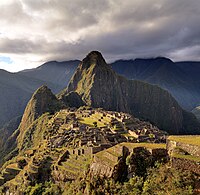 Photo credit: Martin St-Amant
Machu Picchu is a well-preserved pre-Columbian Inca ruin located on a high mountain ridge. Machu Picchu is located above the Urubamba Valley in Peru, about 70 km (44 mi) northwest of Cuzco. Forgotten for centuries by the outside world, although not by locals, it was brought back to international attention by Yale archaeologist Hiram Bingham who rediscovered it in 1911.
 Photo credit: User:Aka
The habanero chile (Capsicum chinense Jacquin) (Spanish, from Havana) is the most intensely spicy chile pepper of the Capsicum genus. Unripe habaneros are green, but the color at maturity varies. Common colors are orange and red, but white, brown, and pink are also seen. Typically a ripe habanero is 2–6 cm (1–2½ in) long. Although habaneros are believed to have originated in Cuba, it is nonetheless an important part of cuisine in the Yucatán peninsula, where it is often served roasted as a condiment with meals. Approximately 1,500 tons are harvested annually in the Yucatán.
 Photo credit:Delphine Ménard
The Area Nacional de Recreación Cajas is a national park in the highlands of Ecuador. The area of 289000ha between 3100m and 4450m above sea level offers a tundra vegetation on a jagged landscape of hills and valleys. About 270 lakes and lagoons can be found. It is located about 30km from Cuenca, the capital of the province of Azuay. It was declared a national park on November 5, 1996.
 Photo credit: Glenn Thomas
Bruno Senna Lalli (born October 15, 1983 in São Paulo) is a Brazilian racecar driver and the nephew of three-time Formula One world champion Ayrton Senna. He competed in the Formula Three support races at the 2006 Australian Grand Prix, winning three of the four races, and is running a second full season in British Formula 3 with Räikkönen Robertson Racing. He has also won the first two races of the 2006 British GP calendar, at Oulton Park. He is currently in second place in 2006 British Formula Three championship, behind teammate Mike Conway.
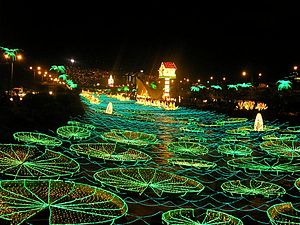 Photo credit:Alejandra Zapata
Medellín is the capital city of the Antioquia Department in Colombia. It was founded in 1616 by Francisco Herrera y Campuzano. As of 2006, Medellín municipality has a population of 2,223,078 inhabitants, making it the second most populated city in Colombia after Bogotá. Medellín also serves as the core of the Valle de Aburrá (Aburrá Valley) metropolitan area, the second largest in Colombia.
 Photo credit: User:PiccoloNamek
Ipomoea purpurea, the Purple or Common Morning Glory, is a species in the genus Ipomoea, native to Mexico and Central America. Like all morning glories the plant entwines itself around structures with its viny stems, growing to a height of 2-3 m tall. The leaves are heart-shaped and the stems are covered with brown hairs. The flowers are bell-shaped, blue to purple, 3-6 cm diameter. The habitats of morning glories are landscapes, fences and crops. The plant is predisposed to moist and rich soil, but can be found growing in a wide array of soil types. It is naturalized throughout warm temperate and subtropical regions of the world. Although it is often considered a noxious weed, Ipomoea purpurea is also grown for its beautiful purple and white flowers and has many cultivars.
 Photo credit: Prissantenbär
Cerro Chaltén, also known as Cerro Fitz Roy or Monte Fitz Roy, is a mountain ('cerro') located near the El Chaltén village, in the Southern Patagonian Ice Field, on the border between Argentina and Chile. It has been agreed by the two countries that the international border detours eastwards to pass over the main summit, but a large part of the border to the south of the summit remains undefined. Although the highest peak in the Los Glaciares park, it is less than half the height of the Himalayan giants. Despite this, the mountain has a reputation of being "ultimate" because the sheer granite faces present long stretches of arduous technical climbing. In addition, the weather in the area is exceptionally inclement and treacherous. It attracts many photographers thanks to its otherworldly shape.
 Photo credit:User:Hadal
The menelaus Blue Morpho (Morpho menelaus) is an iridescent tropical butterfly of Central and South America. It has a wing span of 6 inches (15 centimeters). The adult drinks juice from rotten fruit with its long proboscis, which is like a sucking tube.
The larvae eat plants at night. The larva is red-brown in color with bright patches of lime-green or yellow. The larvae are also highly cannibalistic. |
 Photo credit: Cyc
Pernambuco (pron. Portuguese pronunciation: [pɛx.nɐ̃.ˈbu.ku]) is a state of Brazil, located in the Brazilian Northeast. To the north are the states of Paraíba and Ceará, to the west is Piauí, to the south are Alagoas and Bahia, and to the east is the Atlantic Ocean. Pernambuco is covered mostly by the dry thorny scrub vegetation called caatinga. The Rio São Francisco is the main water source for this area. The coastal area is fertile, and was formerly covered by the Mata Atlântica. It is now occupied by extensive sugar cane plantations. The climate is more bland in the countryside because of the Borborema plateau ("Planalto da Borborema", popularly known as "Serra das Russas" or "Russians' Mountain").
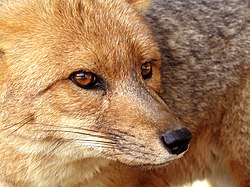 The Culpeo (Pseudalopex culpaeus), sometimes known as the Patagonian fox, is a South American species of wild dog. It is the second largest South American canid after the Maned Wolf. In its appearance it bears many similarities to the widely recognized red fox. It has grey and reddish fur, a white chin, reddish legs, and a stripe on its back that may be barely visible.
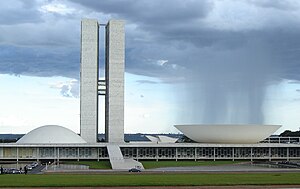 Photo credit: Eurico Zimbres
Since the 1960s, the National Congress of Brazil has had its seat in Brasilia. As with most of the official buildings in the city, it was designed by Oscar Niemeyer following the style of Brazilian modern architecture. The hemisphere to the left is the seat of the Senate, and the hemisphere to the right is the seat of the Chamber of the Deputies. Between them there are two towers of offices. The Congress also occupies other surrounding buildings, some of them interconnected by a tunnel. The building is located in the middle of the Monumental axis, the city main street. In front of it there's a large lawn, where demonstrations take place. At the back of it, there are the Praça dos Três Poderes, where the Palácio do Planalto and the Palace of Justice lie.
 Photo credit:User:Raul654
Silver torch cactus (Cleistocactus strausii) is a succulent of family Cactaceae. It is native to high mountain regions of Bolivia and Argentina. Its slender, erect, grey-green columns can reach a height of 3 m, but are only about 6 cm across. The columns are formed from around 25 ribs and are densely covered with areoles, supporting four yellow-brown spines up to 4 cm long and 20 shorter white radials.
 Photo credit: Keith Weller from the ARS image gallery
The citrus root weevil (Diaprepes abbreviatus) is a major agricultural pest weevil in several Caribbean countries and the US state of Florida. It is also known as the diaprepes root weevil and the sugarcane rootstock borer weevil. The weevil is found on many plants besides citrus, including sugarcane, tuber-bearing crops such as potatoes, and many ornamental plants.
 Photo credit:User:PiccoloNamek
The Mexican beaded lizard (Heloderma horridum) is a lizard found in Mexico and the southern United States that grows up to 18 inches in length. Along with the Gila monster, it was once thought to be one of only two lizards known to be venomous. However, recent research showed that some Iguanas and Monitors also produce venom. Their venom is similar to that of some snakes.
 Photo credit: Ilya Haykinson Lake Argentino (in Spanish, Lago Argentino) is a freshwater lake located in the Patagonian province of Santa Cruz, Argentina, at 50°2′S 72°4′W / 50.033°S 72.067°W. It is the biggest lake in Argentina, with a surface area of 1,466 km2 (566 sq mi), and a maximum width of 20 km (12 mi). It has an average depth of 150 m (490 ft), and a maximum of 500 m (1,600 ft). The lake lies within the Los Glaciares National Park, in a landscape with numerous glaciers and is fed by the glacial meltwater of several rivers, the water from Lake Viedma brought by the La Leona River, and many mountain streams. Its drainage basin amounts to more than 17,000 km2 (6,600 sq mi).
 The Plumed Basilisk (Basiliscus plumifrons) is a species of lizard native to Latin America. Its natural range covers a swath from Mexico to Ecuador. Plumed basilisks are omnivorous and will eat insects, small mammals (such as rodents), smaller species of lizards, fruits and flowers. Their predators include raptors, opossums and snakes.
 Photo credit: Tomás Castelazo
The Ex-Covento, or cathedral is probably the most important architectural structure in Yuriria, one of 46 municipalities in the Mexican state of Guanajuato. It is also an important icon in the state in general. Since its construction in November of 1550, and its culmination on 1559, its massive size and dazzling structure captured the attention of generations, and ultimately put Yuriria on the map. Its construction was started by Fray Diego de Chavez, nephew of the conquistador Don Pedro Alvarado and was designed by the famous architect Pedro del Toro.
 Photo credit: Pismire
The King Penguin (Aptenodytes patagonicus) is the second largest species of penguin at about 90 cm (3 ft) tall and weighing 11 to 15 kg (24 to 33 lb), second only to the Emperor Penguin. There is a world population of approximately four million King Penguins, divided into two subspecies (A. p. patagonicus and A. p. halli). These populations are thought to be on the increase. King penguins eat small fish, and squid and rely less than most Southern Ocean predators on krill and other crustaceans. On foraging trips they repeatedly dive to over 100 metres (350 feet), often over 200 metres (700 feet). King Penguins live on the subantarctic islands at the northern reaches of Antarctica, as well as Tierra del Fuego, the Falkland Islands, and other temperate islands of the region.
 Photo credit: Charles H. Smith
The Golden Toad (Bufo periglenes) was a small, shiny, bright-orange toad that was once abundant in a small region high-altitude cloud-covered tropical forests, about 30 square kilometers in area, above the city of Monteverde, Costa Rica. For this reason, it is sometimes also called the Monteverde Golden Toad, or the Monte Verde Toad. Other common English names include Alajuela Toad and Orange Toad. They were described in 1966, but since 1989, not a single Golden Toad has been seen anywhere in the world, and it is classified by the IUCN as an extinct species. Its extinction is cited as part of the decline in amphibian populations, and attributed to climate change due to global warming.
 Photo credit: Brad Mering
Alpamayo (Spanish: Nevado Alpamayo) is one of the most conspicuous peaks in the Cordillera Blanca mountain range (which is made up of about 50 peaks), part of the Peruvian Andes. In 1966, the Alpamayo mountain was declared "the most beautiful mountain in the world" by UNESCO. Alpamayo is a steep (sixty degrees), almost perfect pyramid of ice, one of a number of peaks that compose the Santa Cruz massif, the northernmost massif of the Cordillera Blanca. Although smaller than many of its neighboring peaks, it is distinguished by its unusual formation and overwhelming beauty. It actually has two sharp summits, North and South, separated by a narrow corniced ridge.
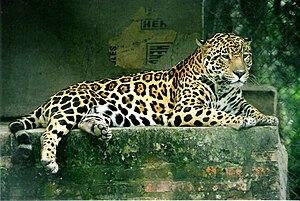 Photo credit:Lea Maimone
The jaguar (Panthera onca) is a New World mammal of the Felidae family. The jaguar is the third-largest feline after the tiger and lion, and is the largest and most powerful feline in the Western Hemisphere. The jaguar's present range extends from Mexico (with occasional sightings in the southwestern United States) across much of Central America and south to Paraguay and northern Argentina. |
